I’ve enjoyed the distinct qualities of both Spring vs Springless trampolines. Spring trampolines, with their traditional design, provide a familiar and exhilarating bounce.
The sturdy springs offer resistance and propel you through the air, creating an exciting experience. They come in various sizes and designs to suit different preferences and budgets.
On the other hand, springless trampolines offer a modern twist by utilizing hidden elastic bands or rods. This innovative design delivers a controlled bounce, ensuring a safer option, especially for younger users, with no risk of pinching or snagging.
Whether you prefer the classic bounce of a spring trampoline or the safer, controlled experience of a springless trampoline, both options promise endless joy and entertainment.
Remember to consider your personal preferences, available space, and safety requirements when choosing the perfect trampoline. So get ready to jump high and have a fantastic time, selecting the trampoline that suits you best!
Spring vs Springless Trampolines: Spring trampolines use metal springs to provide bounce, while springless trampolines use elastic bands or rods. Springless trampolines offer safer jumping with no risk of getting pinched or caught in springs.
What is the Definition of Spring Trampolines?
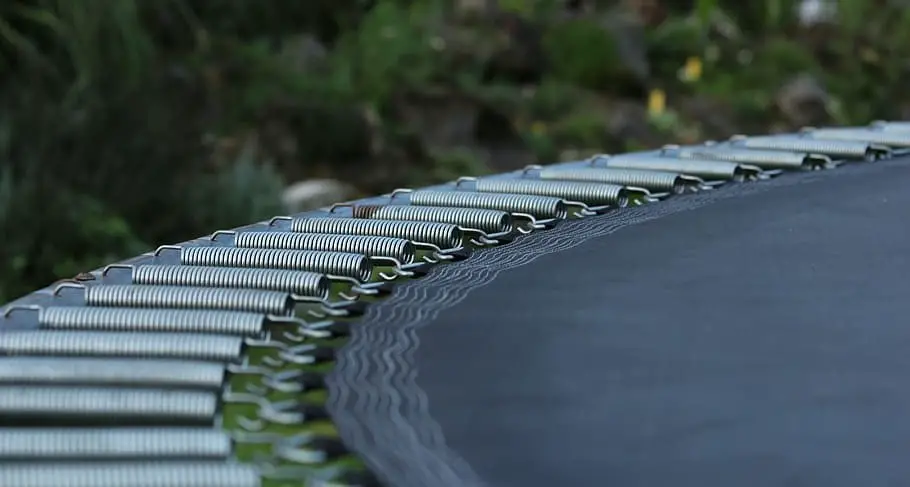
If you had a trampoline in your backyard as a kid and were born before the 2000s, it was probably a spring trampoline. Spring trampolines use metal springs to connect the jumping mat to the frame, which gives them bouncing ability.
These trampolines were first invented by gymnasts George Nissen and Larry Griswold at the University of Iowa in the early 1900s. Over the years, they became popular and a common sight in many homes, providing a fun way for kids to play and release their energy.
Even today, spring trampolines remain the most popular type for backyard use. Many different brands, like JumpSport, Skywalker, and Acon, offer spring trampolines for people to enjoy.
What is the definition of Springless Trampolines?
Springless trampolines are a different kind of trampoline that came out in the early 2000s. Instead of using springs like traditional trampolines, they use things like rods, bungee cords, or elastic straps to make you bounce.
Dr. Keith Alexander invented springless trampolines to make them safer than regular trampolines. He wanted to improve trampoline safety worldwide.
As the years went by, more and more people started choosing springless trampolines for their homes. Other brands like Vuly and Kahuna also started making their own springless trampolines.
The only brand that sells springless trampolines in North America is Springfree Trampoline. They are known for their high-quality and safe trampolines.
Which brands produce Springless Trampolines?
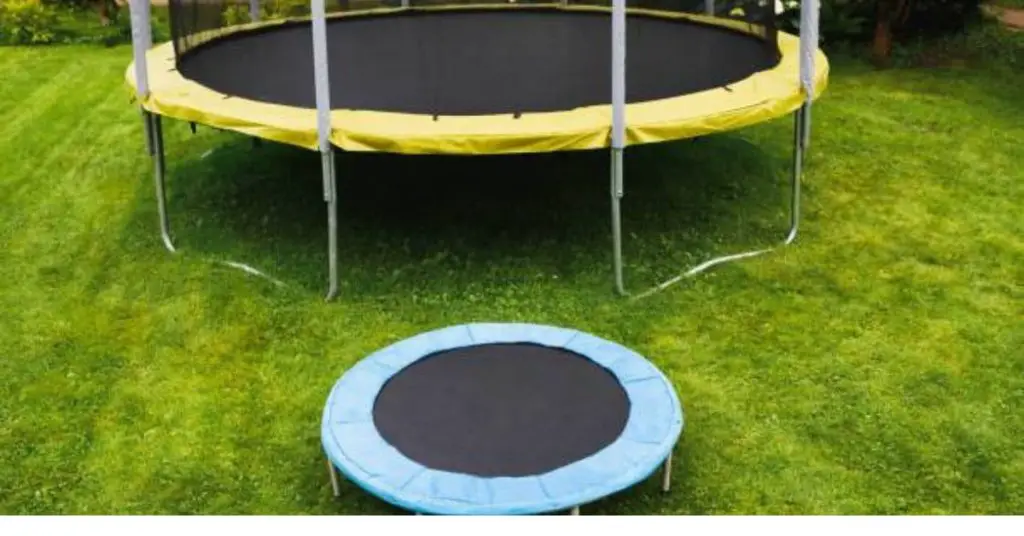
In Australia, four popular brands make springless trampolines:
- Springfree: They are known for their innovative and safe trampoline designs.
- Vuly: They also offer springless trampolines with various features and sizes.
- Kahuna: This brand is recognized for its durable and reliable springless trampolines.
- Lifespan Kids: They specialize in creating springless trampolines designed for children, focusing on safety and fun.
Spring vs Springless Trampolines: Difference
Now, let’s explore the key differences between spring vs. springless trampolines:
Design Differences:
The main difference between spring and springless trampolines is their design.
Spring trampolines use metal springs to provide the bouncing effect, while springless trampolines use alternative materials like composite rods or bungee cords to achieve the bounce.
In terms of appearance, springless trampolines generally have a more attractive design than traditional trampolines; this can vary depending on the specific type you are referring to.
Material Differences:
A spring-based trampoline uses galvanized and rust-proof springs to provide jumping power, while springless trampolines utilize bungee cords or elastic bands for the same purpose. Springs generally have a lower chance of breaking compared to elastic bands.
However, it’s important to note that not all springs are completely rust-proof. Some may become brittle if exposed to the elements for a long time, especially if you choose a lower-quality brand.
With springless trampolines, you can use bungee cords or elastic bands. These materials are resistant to rust since they are not made of metal. However, some lower-quality brands may have elastic bands that can snap after a few weeks.
The advantage of springless trampolines is that even if a cord breaks, you can still safely use the trampoline, although it is recommended to order a replacement as soon as possible.
Safety Differences:
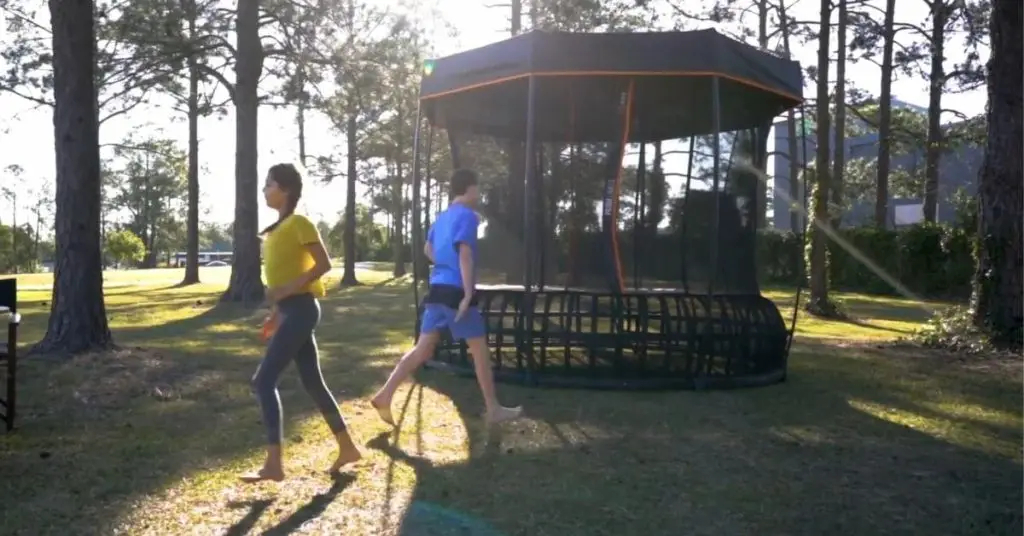
The main difference in design between spring and springless trampolines significantly impacts safety.
Springless trampolines aim to make jumping safer by eliminating the metal springs found in traditional trampolines. Instead, they use rods beneath the jumping surface to separate the jumper from the hard frame.
Metal springs in spring trampolines can cause injuries like pinching to the toes, feet, or hands, and falling onto the springs can lead to more serious injuries.
This is why it is generally believed that springless trampolines are much safer than spring trampolines, especially the cheaper ones.
In addition to the absence of springs, springless trampolines often have better overall safety features. For instance, Springfree Trampolines come with hidden frames, a FlexiNet enclosure system held by flexible rods, and a SoftEdge mat that covers the area where the rods meet the mat.
The SoftEdge mat is 30 times more cushioned than traditional safety pads, providing an extra layer of protection.
Setup Differences:
Most springless trampolines come pre-assembled, so almost no setup is required when you receive them. The elastic bands are already installed and looped around the frame.
However, if you choose a springless trampoline, ensure it has replaceable bands. Some poorly made ones have the bands sewn directly to the mat, which means you won’t be able to replace a broken band.
On the other hand, spring trampolines always require setup. You need to attach each spring from the safety net to the holes in the frame. This can be a bit of work as you have to pull each spring to ensure the jumping mat is not sagging.
Assembly and Portability Differences:
Setting up a spring trampoline involves attaching each spring from the safety net to the corresponding holes in the frame. This process requires some effort as you must ensure that each spring is properly hooked to prevent the jumping mat from sagging. Assembly can be time-consuming and may require the assistance of another person.
Most springless trampolines come pre-assembled, meaning they require minimal setup. The elastic bands or rods are installed and looped around the frame, so you don’t need to attach individual springs.
This makes the assembly process much easier and quicker. Once you receive a springless trampoline, it is typically ready to use immediately.
In terms of portability, both types of trampolines have considerations.
Spring trampolines tend to be bulkier and heavier due to the presence of metal springs. Disassembling and moving them may require more effort and may not be as convenient as springless trampolines.
However, some spring trampolines have features like foldable frames or removable safety nets that can enhance portability.
Springless trampolines are generally designed to be more lightweight and portable. Their construction without bulky springs makes them easier to move around or transport if needed.
Some springless trampolines may also feature folding or disassembling options to further facilitate portability.
Bounce Quality Differences:
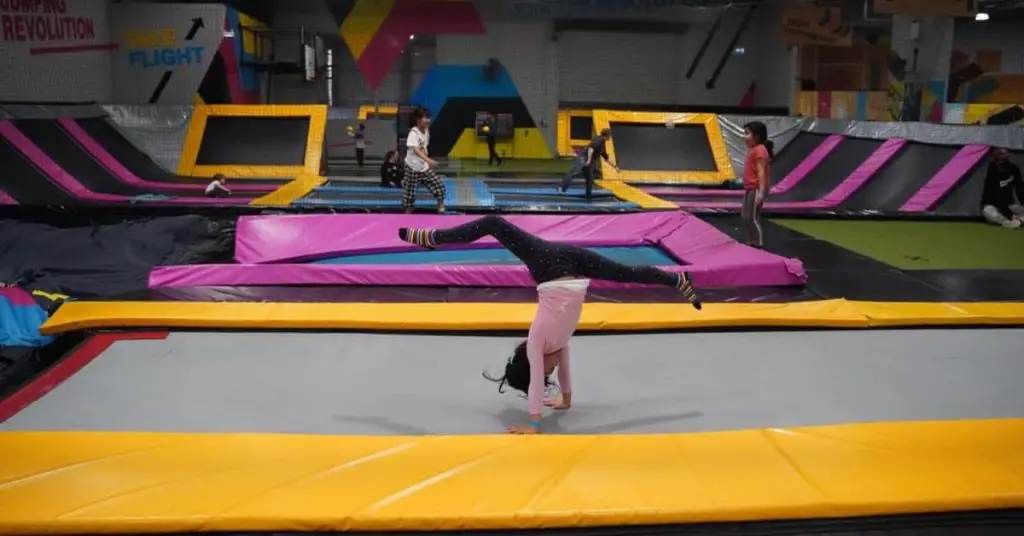
The next difference we’ll discuss is the bounce quality, which is an essential aspect of any trampoline.
In spring trampolines, the bounce is generated by the stretching and recoiling of the metal springs when you jump on them.
On the other hand, springless trampolines use alternative mechanisms like flexible rods beneath the jumping surface to create a bounce.
Determining which type of trampoline offers a better bounce is subjective since it depends on the trampoline in question. Generally, some high-end spring-based trampolines may provide a slightly higher bounce due to the tension of the springs.
However, springless trampolines often offer a softer and more consistent bounce that is gentler on your joints, providing a more comfortable jumping experience.
Maintenance and Durability Difference:
The rods used in springless trampolines are more durable and longer-lasting compared to the springs used in traditional trampolines. Springs are prone to rust and wear over time, while the rods in springless trampolines can withstand aging and weather damage better.
For example, if you take good care of our Springless Trampolines and follow safe jumping practices, they can last for at least 10 years without losing their solid bounce.
In contrast, it’s much harder for a spring trampoline to reach that longevity, especially cheaper models that are more susceptible to damage.
Maintenance can be a hassle for spring trampolines. You may need to replace the safety padding around the springs at least once a year, especially if the trampoline is used frequently.
On the other hand, springless trampolines are typically made with stronger materials, reducing the need for replacement parts. Basic cleaning of the trampoline is usually sufficient to maintain its condition.
Noise and Squeakiness Difference:
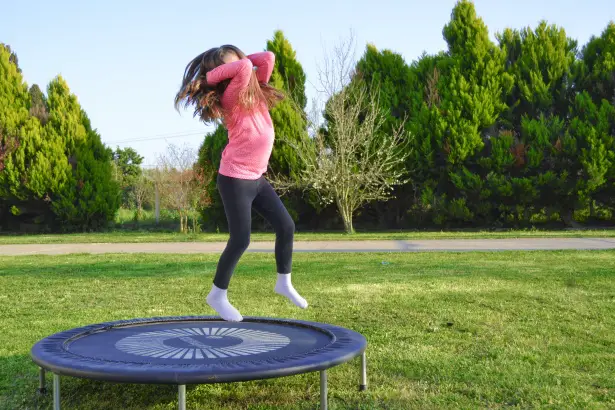
Spring trampolines often produce more noise and squeaks compared to springless trampolines. The metal springs can create creaking sounds as they stretch and compress during jumping. Over time, the springs may develop rust or wear, leading to increased noise and potential squeaking.
Springless trampolines tend to be quieter during use. Without the metal springs, there is less potential for squeaks or creaking sounds. The absence of spring-related noise can contribute to a more peaceful and enjoyable jumping experience.
It’s important to note that noise levels can vary depending on the trampoline model and its overall construction quality.
Regular maintenance and lubrication of spring trampolines can help reduce noise, but springless trampolines offer a quieter jumping experience.
Price Difference:
The price difference depends on the specific trampoline model. Let’s look at four examples to illustrate this:
- Skywalker 12 ft Round Trampoline (Low quality, with springs) – $299
- JumpFlex Flex120 12 ft Trampoline (Good quality, with springs) – $649
- JumpSport AlleyOOP 12 ft Trampoline (High quality, with springs) – $1,849
- Springfree Large Square 11 ft Trampoline (Best quality, springless) – $1,900
As you can see, as the trampoline quality increases, so does the price. It’s similar to buying clothes, cars, or food – you can choose a lower-quality option for a lower price or invest more in a higher-quality option for a higher price.
Ultimately, deciding which trampoline to choose depends on your goals and how much you’re willing to spend.
User Reviews and Recommendations:
When choosing between spring and springless trampolines, it can be helpful to consider user reviews and recommendations. Hearing from other trampoline owners can provide insights into the overall satisfaction, durability, and performance of different trampoline models.
- Online Reviews: Check customer reviews on retailer websites or independent review platforms. Look for feedback on factors such as ease of assembly, bounce quality, durability, and safety features. Pay attention to common themes and patterns in the reviews.
- Recommendations from Friends and Family: Talk to friends, family, or neighbors who own trampolines and ask about their experiences. They can share firsthand information about the specific trampoline model they own, including any pros and cons they’ve encountered.
- Online Communities and Forums: Participate in online communities or forums dedicated to trampoline enthusiasts. Engage with fellow trampoline owners, ask questions, and seek recommendations. These communities can provide valuable insights and recommendations based on personal experiences.
- Expert Reviews: Look for reputable websites or publications specializing in trampoline reviews. Experts often thoroughly evaluate various trampoline models and provide detailed assessments based on safety, durability, bounce quality, and overall performance.
While user reviews and recommendations are helpful, it’s essential to consider the individual preferences and priorities of reviewers. What works well for one person may not necessarily be the best choice for another.
Therefore, gathering various opinions and making an informed decision based on your specific needs and preferences is advisable.
What makes Springfree trampolines safer compared to trampolines with springs?
If you’re not familiar with what a spring-free trampoline looks like, let me provide a detailed description. Instead of having metal springs connecting the jumping mat to the frame in a spring-free trampoline, it utilizes a distinct design with diagonal composite rods.
When you look at a picture of an oval spring-free trampoline, you will notice the absence of traditional springs. Instead, sturdy composite rods are positioned diagonally beneath the jumping surface. These rods serve as the main support system, replacing the need for springs.
The diagonal placement of the composite rods is intentional and contributes to the trampoline’s safety. It helps to distribute the force of each jump more evenly across the surface, reducing the risk of concentrated pressure points or uneven bouncing areas.
This design also enhances the overall stability of the trampoline, preventing tipping or wobbling during use.
By eliminating traditional springs, spring-free trampolines significantly reduce the chances of accidents such as pinching injuries that can occur when body parts come into contact with the springs.
The absence of springs also eliminates the potential for users to fall through or get caught in the gaps between the springs and the jumping mat.
In addition to the unique rod design, spring-free trampolines often incorporate other safety features. These may include a hidden frame, flexible enclosure rods, and specially designed padding to cover the areas where the rods meet the mat, providing an extra layer of protection.
Overall, the distinctive design of spring-free trampolines with diagonal composite rods enhances safety by eliminating springs and reducing the associated risks.
Edge Net Design in Springfree Trampolines
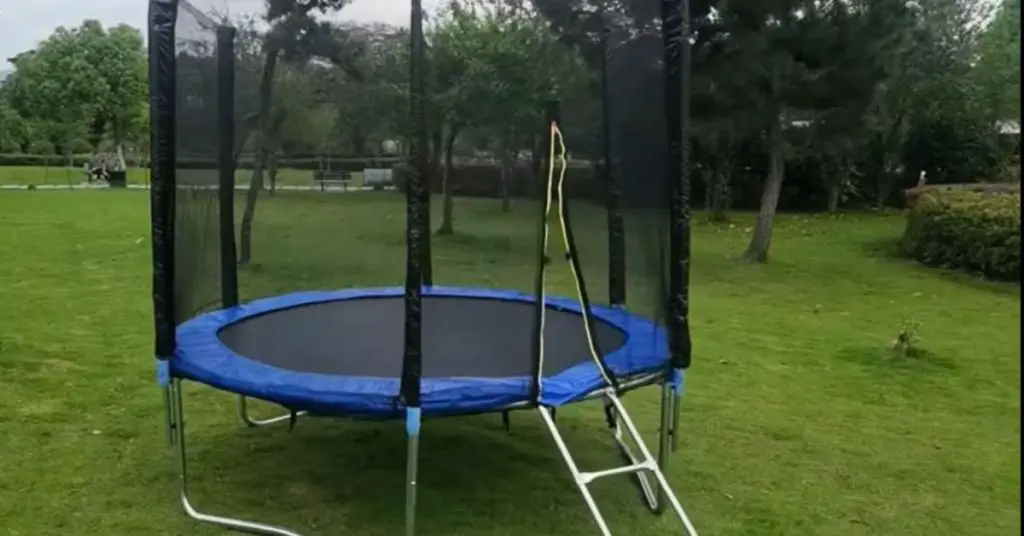
Springfree trampolines have a unique safety feature where the safety net is positioned right at the edge of the jumping mat. This design ensures that children cannot fall off the trampoline while bouncing.
In contrast, spring trampolines have a different design where the mat is located in the center, surrounded by springs (usually covered with a pad), and then the safety netting is placed on the outer side of the springs.
This arrangement creates a potential risk where children can fall or get caught between the springs if the padding moves or slips, or if the padding is removed due to mold or other reasons.
The continuous attachment of the net to the mat in spring-free trampolines eliminates the possibility of children falling off the trampoline during bouncing, providing parents an added level of safety and peace of mind.
‘No Climb’ Nets in Springfree Trampolines
Trampoline nets are safety nets that surround the trampoline to prevent kids from falling off.
Modern trampoline nets have increased in height, ranging from 6ft to 8ft, considering the height of the trampoline itself. However, if children manage to reach the top and lean over the outer side, it can result in a significant fall.
‘No-climb’ nets are designed to prevent kids from climbing to the top of the netting. The holes in these nets are too small for fingers or toes to get a good grip, ensuring added safety.
These ‘no-climb’ nets are gaining popularity, not only for regular spring trampolines but also for spring-free trampolines. In the case of spring-free trampolines, ‘no-climb’ nets are already a standard feature, providing an extra layer of protection and peace of mind.
Related articles: What is the Average Weight Limit for a Trampoline
Flexible Net Frame in Springfree Trampolines
Traditional trampolines typically have vertical steel or wooden posts supporting the enclosure net. These posts can be painful or dangerous to bounce into, causing potential injuries.
On the other hand, spring-free trampolines feature a flexible net enclosure system. The supporting posts are designed to bend outward in a concave shape.
So, when you accidentally run into the net, the posts flex outward slightly. This design ensures that you won’t crash into rigid posts, making it safer and reducing the risk of injury.
Who would be a suitable candidate for a spring trampoline?
A spring trampoline would be a good choice for you if:
- You are looking for an affordable or moderately-priced trampoline.
- You need a trampoline for temporary or short-term use, such as if you believe your child will not use it for an extended period.
- You want a wide range of options, as most trampoline brands offer spring-based models.
- You prefer the traditional look of trampolines with visible springs.
Who would benefit from a springless trampoline?

If you’re looking for a trampoline that’s safe for your family, lasts longer, and requires less maintenance, then a springless trampoline might be right for you.
Additionally, a springless model may be a better fit if you prefer the look of a trampoline without springs.
However, if you’re looking for a more affordable or short-term solution or prefer the traditional look of a trampoline with springs, a spring-based trampoline might be a better fit. It’s important to consider your needs and preferences before making a decision.
Factors to Consider
There are several important factors to consider when choosing between a spring vs springless trampoline. These include:
Safety Considerations for Both Types:
- Enclosure systems and padding: Look for trampolines with sturdy enclosure systems that keep users safely contained within the jumping area. Ensure that the padding around the trampoline’s edges is thick and in good condition to prevent injuries from accidental falls.
- Weight limits and age restrictions: Be aware of the trampoline’s weight capacity to safely support the intended users. Also, consider any age restrictions or guidelines provided by the manufacturer to ensure the trampoline is suitable for the intended age group.
Space and Budget Considerations:
Consider the available space in your yard or designated area for the trampoline. Measure the dimensions and choose a trampoline that fits comfortably within the available space. Additionally, determine your budget range and look for trampolines that balance cost and quality.
User Preferences and Intended Use:
Think about the preferences of the trampoline users, including their age, skill level, and specific interests. Consider whether the trampoline will be primarily used for recreational bouncing, fitness purposes, or specific activities like gymnastics. This will help you choose a trampoline that aligns with the users’ needs and interests.
Comparison of Available Models and Brands:
Research and compare different trampoline models and brands. Review customer reviews and ratings to gauge the trampolines’ quality, durability, and performance. Consider factors such as warranty, customer support, and additional features each brand offers.
By carefully considering these factors, you can make an informed decision when choosing a trampoline that meets your safety requirements, fits your available space and budget, aligns with user preferences, and comes from a reputable brand.
Additional Tips and Recommendations
Here are some additional tips and recommendations:
- Check Safety Certifications: When buying a trampoline, look for safety certifications from reputable organizations. Certifications like ASTM or TUV/GS indicate that the trampoline meets certain safety standards.
- Consider Enclosures: Regardless of the trampoline type, investing in a safety enclosure is crucial. Enclosures provide an added layer of protection by preventing users from falling off the trampoline.
- Read User Reviews: Before making a purchase, read user reviews and testimonials about the specific trampoline models you are considering. Real-world experiences from other customers can give you valuable insights into the product’s performance and durability.
- Test Before Buying: If possible, visit a local store or trampoline park that has the models you’re interested in and test them out. This hands-on experience can help you get a feel for the bounce and overall performance.
- Consider Weather Resistance: If your trampoline will be placed outdoors, look for weather-resistant materials like galvanized steel frames and UV-resistant jumping mats to ensure it can withstand various weather conditions.
- Research Brand Reputation: Look into the reputation of the trampoline manufacturer. Brands with a history of quality products and positive customer experiences are more likely to provide reliable and safe trampolines.
- Spare Parts Availability: Check if the manufacturer offers easy access to spare parts and replacements. Having readily available spare parts can extend the trampoline’s lifespan and save you from the hassle of searching for compatible components.
- Set Up on Level Ground: Ensure the trampoline is set up on level ground to prevent instability and potential accidents. Avoid placing it on slopes or uneven surfaces.
- Establish Safety Rules: Establish clear safety rules for trampoline use, especially if children will be using it. Rules like one jumper at a time, no somersaults, and adult supervision can minimize the risk of injuries.
- Regular Maintenance: Regularly inspect and maintain the trampoline to keep it in good condition. Check for any loose or damaged parts and perform maintenance tasks as recommended by the manufacturer.
- Warranty Coverage: Review the warranty coverage for the trampoline. A longer warranty period can provide added peace of mind and protection against potential defects.
- Age and Weight Limits: Be aware of the trampoline’s recommended age and weight limits. Adhering to these limits ensures safe and optimal usage.
By considering these additional tips and recommendations along with the factors outlined in the guide, you can make a well-informed decision and choose the trampoline that best suits your needs and preferences while prioritizing safety and enjoyment.
Which Trampoline Suits Your Needs?
When choosing a trampoline, you have two main types to consider: ones with springs and ones without springs. This choice impacts safety, quality, bounce, durability, maintenance, and price. It’s essential to explore both options before making a decision.
Once you know which type you want, you can focus on specific trampoline models. With so many options available, it can be overwhelming to find the right one. To help you out, we’ve written an article summarizing seven crucial factors to consider when buying a trampoline.
These factors will guide you in setting your goals and finding the perfect trampoline that will bring joy to your family for years to come.
FAQs:
Q:1 Are springless trampolines better?
Springless trampolines offer a controlled bounce and eliminate the risk of pinching or snagging. However, whether they are better than spring trampolines is subjective and depends on individual preferences.
Q:2 Are springless trampolines worth it?
Springless trampolines can be worth it for those who prioritize safety and prefer a controlled bounce. However, the decision ultimately depends on individual preferences and specific needs.
Q:3 What is the difference between springless and spring trampoline
Spring trampolines use springs to provide bounce, while springless trampolines utilize alternative mechanisms such as elastic bands or rods. Springless trampolines offer a controlled bounce and eliminate the risk of pinching or snagging.
Q:4 Are springless trampolines safer than spring trampolines?
Springless trampolines are often considered safer as they eliminate the risk of
pinching or snagging that springs may pose. However, both types can be safe when used correctly and with proper safety measures.
Q:5 Do springless trampolines provide a comparable bounce to spring trampolines?
Spring trampolines typically offer a more traditional and higher bounce due to the tension provided by the springs. Springless trampolines provide a controlled bounce that some users prefer for its predictability.
Q:6 Are springless trampolines more expensive than spring trampolines?
Generally, springless trampolines tend to be slightly more expensive due to their innovative design and specialized components. However, the price difference can vary depending on the brand, size, and features.
Q:7 Which type of trampoline is easier to maintain?
Both types require some maintenance, but springless trampolines may require less upkeep since there are no springs to check or replace. However, following the manufacturer’s maintenance instructions is essential for optimal performance.
Conclusion:
In conclusion, the choice between spring trampolines and springless trampolines ultimately depends on personal preferences, safety considerations, and specific needs.
Spring trampolines offer a classic bounce experience with the familiar sensation of springs providing resistance and propulsion. They come in various sizes and designs, catering to various preferences and budgets.
On the other hand, springless trampolines provide a modern twist, offering a controlled bounce and eliminating the risk of pinching or snagging. They are often considered safer, especially for younger jumpers.
Both types of trampolines have their advantages and considerations. Spring trampolines provide a higher bounce and can deliver a more traditional experience, while springless trampolines prioritize safety and offer a more controlled and predictable bounce.
When deciding, it is essential to consider factors such as bounce preference, safety concerns, maintenance requirements, and budget constraints.
Ultimately, whether you opt for a spring trampoline or a springless trampoline, both options offer endless joy, entertainment, and a fantastic way to engage in physical activity.
It’s important to choose the trampoline that aligns with your preferences and meets your safety requirements. So go ahead, make an informed decision, and jump into hours of fun and excitement!
We hope you will be well aware of Spring vs Springless trampolines after reading this comprehensive article. If you have any questions, feel free to comment below!

